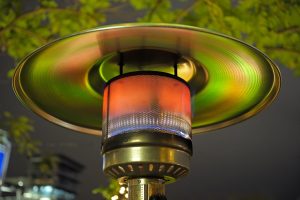Patio heaters are lovely for keeping us warm outside in the cold, but we need to use them safely to avoid potential fire and carbon monoxide hazards.

Photo credit: iStock.com/jacus
This winter, during the pandemic, many people are turning to patio heaters for warmth outside – where the risk of COVID-19 transmission can be lower. According to this CBC story, there’s been a huge increase in demand from homeowners, as well as from restaurants, pubs, and other commercial spaces.
Patio heaters use one of three kinds of energy or fuel source: propane, natural gas, or electricity. All patio heaters pose a potential fire hazard; those using propane or natural gas pose the hazard of carbon monoxide exposure too.
In Warming up to patio heaters: how to stay safe this winter season, Technical Safety BC reaches out with an important safety message. The most crucial point is that patio heaters are intended for outdoor use only and cannot safely be used indoors (including inside a garage or a four-walled tent). Another point is that it’s essential to follow the safety instructions from the manufacturer of the heater you choose.
Technical Safety BC’s article refers to a tip sheet from the Canadian Propane Association. Here are a few (of many more) tips from that sheet:
- Fire hazards can be located around, above, or underneath heating units and can include combustible materials such as umbrellas, awnings, tablecloths, paper products, decorations, etc.
- Never move portable heaters while the flame is lit. Make sure the fuel supply is properly shut off and the unit is cool before relocating.
- Do not position patio heaters next to or in the path of an exit, including fire escapes. Do not obstruct firefighting equipment such as fire hydrants and fire department connections.
- Seek medical attention if you are showing physical symptoms of CO poisoning (headaches, nausea, dizziness, drowsiness, confusion, impaired judgment, loss of manual dexterity).
See the full list of tips and detailed information about propane safety in Patio Heater Safety Guidelines.
Carbon monoxide gas is toxic, odourless, and invisible
In Carbon monoxide exposure from heaters in outdoor dining spaces, WorkSafeBC reminds us that using combustion heaters (burning propane or natural gas) in unventilated, enclosed spaces like restaurant patios, can expose people to carbon monoxide (CO) gas. The advice applies to enclosed outdoor spaces at home too.
“If you intend to enclose your outdoor space and supply supplementary heat using propane or natural gas units, you must consider the risk of carbon monoxide exposure,” the risk advisory warns.
It explains that CO gas results from incomplete combustion of any carbon-containing material and that because we cannot see or smell the gas, we may not realize we are in danger. “The effects of CO poisoning vary from person to person and depend on the amount and length of exposure,” at worst including collapse, coma, and death.
An electric (infrared) heater — plugged into a ground-fault circuit interrupter (GFCI) outlet — may be safer. Assess your space and research your options to determine what’s best for your home (or workplace).
For more information about propane in the workplace, see my posts Working safely with propane cylinders and Helping food truck owners put propane safety on the menu.


